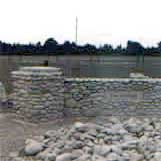Praxis
Praxis?
Basically an obscure term for ‘the way we do things’. And the way that we ‘do them’ is extremely important to us. As we mentioned on our home page, we like to think that we are maintaining traditions and practices that stretch back into architectural prehistory (and I’m not just talking about having a beer on a Friday afternoon). All jokes aside, we do actually put a lot of thought into the way we build. So, what follows is a summary of the techniques that shape, and the ideas which inform, our work.
Traditional techniques
There is absolutely nothing natural about stonework - apart from a bit of geology.
One of the most unfortunate briefs the stonemason can receive is the plea: “I want it to look natural”. It goes without saying that stone is one of our most ancient building materials. It is as natural and elemental as the earth we stand on. However, there is nothing natural about the act of shaping stone and putting it into some sort of architectural order. In fact, far from being part of the natural world, the birth of stonemasonry marks the very beginnings of artifice and architecture-the birth of all that is man-made. What does the ruin call to mind? Geology? Certainly not. It speaks to our collective memory of the ancient cultures that created it. Stonemasonry may well be one of our earliest intellectual acts, and the techniques of its production persist to this day.
Bonding
Even the simplest sentence requires the writer to understand the rules and conventions of language. For without some understanding of language’s structural regulations, meaningful communication would be impossible. Masonry also has a set of conventions that invest it with structural and aesthetic meaning. Of course, these rules are infinitely fewer and less complex than written language, yet it is surprising how many contemporary designs display a complete ignorance of their existence. They can be summed up in a single word: the bond.
Bonding is the set of conventions that permeates all traditional masonry. Like all great ideas or techniques, its rules are relatively simple, yet the results that it produces are infinitely varied. The same principles that are present in the humblest drystone wall, are also present in the most ornate and magnificent cathedral. Put simply, the bond refers to the way in which masonry units are placed together in a wall. If we call to mind the image of a simple brick wall, the first thing that we notice is that the bricks conform to a pattern or bond. The most elementary of these is stretcher bond, in which each brick spans half way across the two bricks below it.
Both brickwork and stonework have many bonds, and it’s not possible to give an exhaustive explanation of them here. It is possible, however, to explain the three basic tenets of bonding. Firstly, all perpendicular or vertical joints must be spanned by the masonry unit above. In other words, the vertical joints in a wall should never line up -they should be as staggered as possible. If you trace the vertical joints in this photograph, you’ll see that they conform to this rule. This is the essence of good bonding. Secondly, all cornerstones in masonry should be returned and never mitered. Lastly, as a general rule, no stone should ever be taller than it is wide. Good bonding is based on thousands of years of structural sense. It is the reason why traditional structures, based on compressive engineering, don’t fall down. Apart from this structural function, good bonding has an aesthetic element as well. The rules of traditional bonding set the visual parameters of the stonemason’s craft. They place our contemporary work within an ancient dialogue. Working outside of, or in ignorance of these rules, creates little more than visual chaos. For these, and many other reasons, traditional bonding is of primary importance in our practice.
Local materials
We make every effort to use stone that is quarried from the local area in which we are building. This practice, apart from making economic and utilitarian sense, also protects the unique architectural character of each region, Once again, in conjunction with the use of traditional techniques, it places contemporary buildings within a cultural and historical context.
Simple and appropriate design
In the projects that we design, and in the way that we interpret the designs of others, we look for a degree of simplicity. The thinking behind this is based on the fact that stone is always already a highly detailed material. The use of busy or tricky details, not only detracts from the beauty and simplicity of the material, it also adds unnecessarily to the cost of a project.
In our design work we pay particular attention to the level of (in)formality appropriate to each project. Obviously, we don’t decry the use of details on all projects, and important public and historic buildings sometimes warrant the use of refined architectural detail. Garden walls, however, do not. In the same way that you wouldn’t head down to the local pub in tophat and tails, we don’t build public monuments in country lanes.
Hopefully this page has given you some idea about the way we work. If you contact us we’ll be happy to answer any questions or discuss its content.

